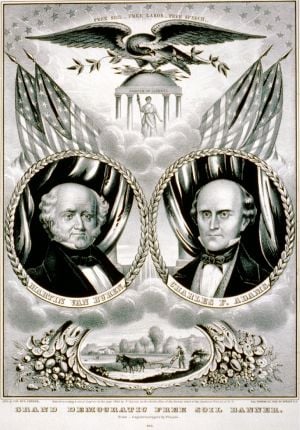Difference between revisions of "Free Soil Party" - New World Encyclopedia
Laura Brooks (talk | contribs) (import, credit and version number) |
Laura Brooks (talk | contribs) |
||
| Line 47: | Line 47: | ||
*[[Walt Whitman]] | *[[Walt Whitman]] | ||
| − | + | ||
| − | |||
| − | |||
| − | |||
==References== | ==References== | ||
Revision as of 02:32, 26 April 2007
The Free Soil Party was a short-lived political party in the United States active in the 1848 and 1852 presidential elections, and in some state elections. It was a breakaway faction of the Democratic party and was largely absorbed by the Republican party in 1854. Its main purpose was opposing the expansion of slavery into the territories, arguing that free men on free soil comprised a morally and economically superior system to slavery. The free soilers were against the expansion of slavery but not the idea of slavery, their goal was to gain the land to the west, and keep the land free of slaves.
Positions
Free Soil candidates ran on the platform declaring "...we inscribe on our banner, 'Free Soil, Free Speech, Free Labor and Free Man,' and under it we will fight on and fight ever, until a triumphant victory shall reward our exertions."
The party also called for a homestead act and a tariff for revenue only. The Free Soil Party attracted mainly abolitionists from the North and other free states. Their main support came from Yankee-settled areas of upstate New York, western Massachusetts and northern Ohio, though other states also had representatives.
First convention
In 1848, their first party convention was in Buffalo, New York, where they nominated former Democratic President Martin Van Buren with Charles Francis Adams as Vice President. The main party leaders were Salmon P. Chase of Ohio and John P. Hale of New Hampshire. They won no electoral votes. The nomination of Van Buren had the adverse effect of discouraging many anti-slavery Whigs from joining the Free Soil Party.
Compromise of 1850
The Compromise of 1850 undercut the party's no-compromise position, and its vote fell off sharply.
Legacy
The Free Soil Party was a notable third party. More successful than most, it had two Senators and fourteen Representatives sent to the thirty-first Congress. Their Presidential nominee in 1848, Martin Van Buren, received 291,616 votes against Zachary Taylor of the Whigs and Lewis Cass of the Democrats, although he received no electoral votes. The Party's "spoiler" effect in 1848 may have put Zachary Taylor into office, in a narrowly-contested election.
The strength of the party, however, was its representation in Congress. The sixteen elected officials were able to have an influence despite being a small group. Its most important legacy was as a route for anti-slavery Democrats to join the new Republican coalition.
Presidential candidates
| Year | Presidential candidate | Vice Presidential candidate | Won/Lost |
|---|---|---|---|
| 1848 | Martin Van Buren | Charles Francis Adams | Lost |
| 1852 | John P. Hale | George W. Julian | Lost |
Famous Free Soilers
- Charles Francis Adams
- Salmon P. Chase
- Charles Sumner, U.S. Senator from Massachusetts
- Oren B. Cheney, legislator from Maine, founder of Bates College
- William Cullen Bryant
- Walt Whitman
ReferencesISBN links support NWE through referral fees
- Frederick J. Blue; Salmon P. Chase: A Life in Politics 1987
- Frederick J. Blue. The Free Soilers: Third Party Politics, 1848-54 (1973)
- Martin Duberman; Charles Francis Adams, 1807-1886 1968.
- Eric Foner; Free Soil, Free Labor, Free Men: The Ideology of the Republican Party before the Civil War 1970
- T. C. Smith, Liberty and Free Soil Parties in the Northwest (New York, 1897)
Credits
New World Encyclopedia writers and editors rewrote and completed the Wikipedia article in accordance with New World Encyclopedia standards. This article abides by terms of the Creative Commons CC-by-sa 3.0 License (CC-by-sa), which may be used and disseminated with proper attribution. Credit is due under the terms of this license that can reference both the New World Encyclopedia contributors and the selfless volunteer contributors of the Wikimedia Foundation. To cite this article click here for a list of acceptable citing formats.The history of earlier contributions by wikipedians is accessible to researchers here:
The history of this article since it was imported to New World Encyclopedia:
Note: Some restrictions may apply to use of individual images which are separately licensed.
